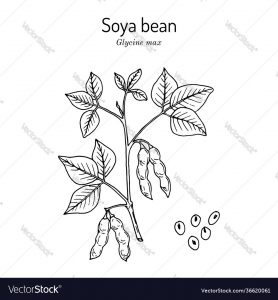
1. Product specifications
- Size: 10ug or 50ug
- Format: Liquid
- Formulation: Supplied as a 0.45 µm filtered solution in 20 mM NaH2PO4 (pH 7.4), 0.5 M NaCl, 80 mM imidazole.

- Purification: His-tag affinity purification by immobilized metal ion affinity chromatography (IMAC)
- Concentration: Lot specific (see label on the vial), determined by Bio-Rad Protein Assay Dye Reagent Concentrate.
- Purity: >90%
- Purity determined by: SDS-PAGE under reducing conditions and visualized by Coomassie blue staining
- Recommended applications: Protein-protein interaction, Post-translational modifications, ELISA, EIA, Western Blotting, Dot Blotting, Immunoprecipitation, Protein Array, etc.
2. Preparation
- Expression System: E.Coli
- Conjugation/Tag: N-terminal histidine tag
- Molecular weight (kDa): 14
Abstract
Glycine max (Soybean) recombinant is an important legume crop grown in the United States and around the world. In 2016, soybeans were valued at $41 billion dollars in the United States alone. Increasingly, soy farmers are adopting alternative management strategies to improve the sustainability and profitability of their crops. Several benefits have been demonstrated for alternative management systems, but their effects on soybean-associated microbial communities are not well understood. To better understand the impact of crop management systems on the soybean-associated microbiome, we employed DNA amplicon sequencing of the internal transcribed spacer (ITS) region and 16S rRNA genes to analyze associated fungal and prokaryotic communities with soil, roots, stems, and leaves Soybean plants were sampled from replicate fields under organic, conventional, and long-term no-till management systems at three-time points throughout the growing season.
Results indicated that sample origin was the main driver of beta diversity in soybean-associated microbial communities, but management regimen and plant growth stage were also important factors. Similarly, differences in alpha diversity are driven by compartment and sample origin. In general, the organic management system had a lower diversity of fungi and Shannon bacteria. In the prokaryotic communities, the surface tissues were dominated by Sphingomonas and Methylobacterium, while the subterranean samples were dominated by Bradyrhizobium and Sphingomonas. Aerial fungal communities were dominated by Davidiella in all management systems, while underground samples were dominated by Fusarium and Mortierella.

Specific taxa, including potential benefits to plants, such as Mortierella, were indicator species for conventional and organic management systems. No-till management increased the abundance of clumps known to contain beneficial plant organisms, such as Bradyrhizobium and Glomeromycotina. Network analyzes show that different highly connected core taxa were present in each management system. Overall, this research demonstrates how specific long-term crop management systems alter microbial communities and how those communities change throughout soybean growth.
3. Fountain
- Genetic symbols: glym 3
- Species: Glycine max
- Access number: O65810
- Expressed region: Ser2-Tyr131
- Protein name and synonyms: Gly m 3, Profilin-2, GmPRO2.
4. Stability and Storage
- Shipping: Ice packs
- Storage/Stability: Upon arrival, protein can be stored for 2 weeks at 4°C. For long-term storage, it is recommended to store at -20°C or -80°C in suitable aliquots. Avoid repeated cycles of freezing and thawing.
